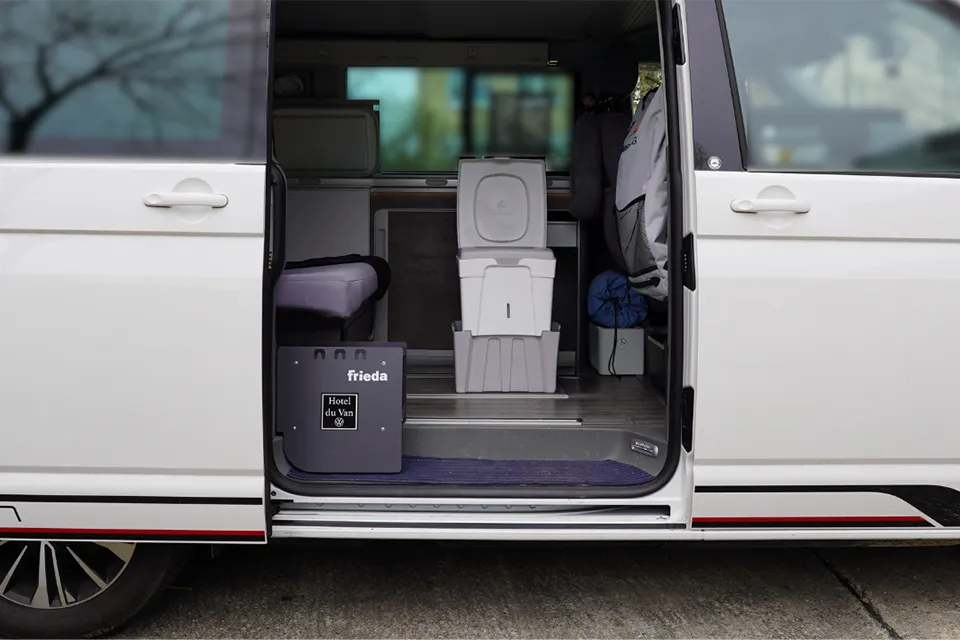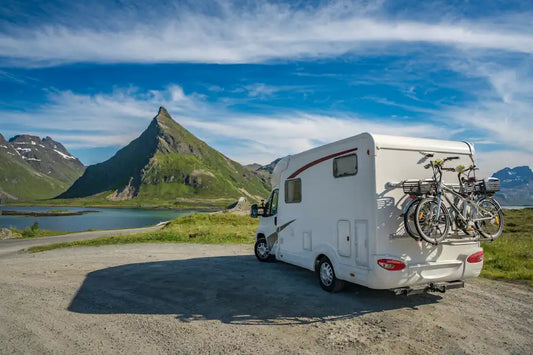What is a portable camping toilet and how does it work?
A portable camping toilet is a self-contained toilet system designed for use anywhere – whether inside your camper van, at a campsite, or out in nature. There are three main types of portable camping toilets: chemical toilets, bucket toilets, and composting toilets. Each type functions differently and comes with its own advantages and drawbacks. Let’s have a closer look at each of these.
Chemical toilets
Chemical toilets use synthetic additives to break down waste and reduce odors. They consist of a toilet seat connected to a sealed waste tank, where chemicals are added to dissolve solids and mask unpleasant smells.
While these toilets may seem inexpensive at first, they come with ongoing costs, as you constantly need to purchase chemical additives for them to function properly. The high-quality chemicals recommended by the manufacturer tend to be quite expensive, leading many users to try cheaper alternatives, which often perform poorly. As a result, people frequently switch back to the manufacturer-recommended chemicals, increasing long-term costs. Additionally, a chemical toilet cannot be used at all if you run out of additives, making it far less practical for longer trips.
Pros:
- No need for an external power or water supply
- Low acquisition costs
Cons:
- Requires regular refilling of expensive chemicals
- Produces a harmful mixture of excrements, urine and chemicals that must be emptied at special disposal stations
- Can develop strong odors
- Messy and unpleasant to empty
Bucket toilets
Bucket toilets are the simplest type of portable toilet. They consist of a basic bucket with a toilet seat on top. While they are a budget-friendly option, they lack any real odor control or hygiene benefits. Bucket toilets require frequent emptying, while the emptying and disposal process of the mixed solid and liquid waste is difficult and unhygienic.
These toilets can be a temporary solution if no other options are available, but they are not suitable for long-term use due to their limited functionality and hygiene concerns.
Pros:
- Inexpensive and easy to set up
- No need for chemicals
Cons:
- No odor control, which makes them unpleasant to use
- Waste disposal can be unhygienic and inconvenient
- Not a long-term or comfortable solution
Composting toilets

Composting toilets offer an alternative to chemical-based systems and simple bucket toilets by using natural processes to manage waste. However, not all composting toilets work in the same way.
Some models are designed to fully compost waste inside the toilet itself. While this may sound convenient, in reality, the composting process takes a lot of time. This makes them impractical for mobile use, as you would essentially be driving around with a composter in your vehicle, waiting for the waste to break down before it can be emptied somewhere.
Our TROBOLO composting toilets take a different approach by using a separation system. These urine-diverting composting toilets direct liquid and solid waste into separate containers, making disposal clean and simple.
Solid waste is collected in an inlay and can be emptied easily into regular waste bins or an external composting system if desired. If you choose to compost your solid toilet waste just make sure to use a compostable inlay. Liquids can be disposed of in a regular toilet or another appropriate location. This system also helps to prevent odors naturally, operates without water, electricity, or chemicals, and offers an environmentally friendly, sustainable solution with the option to compost.
For camping, van life, and off-grid travel, composting toilets with a separation system offer a practical, low-maintenance solution while keeping waste disposal simple and hygienic.
Pros:
- No need for water, electricity, or chemicals
- Composting toilets with separation system naturally minimize odors
- Simple and hygienic waste disposal options
- Environmentally friendly and sustainable
- Litter for enhanced odor prevention is optional and inexpensive (e.g. saw dust)
Cons:
- Litter necessary for extended periods of odorless use
- Not feasible to compost inside the toilet
Where do you empty a portable camping toilet?

Emptying a portable camping toilet is straightforward if you opt for a TROBOLO composting toilet. The liquids container can be emptied into a regular toilet at gas stations, campsites, or other facilities. Solid waste, contained within an inlay, can be disposed of in regular household or campsite waste bins, just like used diapers. This simple disposal method makes these toilets hygienic, odorless and hassle-free.
In contrast, emptying a chemical toilet is far more inconvenient and often an unpleasant experience. As waste and chemicals mix into a single tank, it must be emptied at designated disposal stations, which are not always easy to find. The process can be messy and time-consuming, as the entire tank needs to be thoroughly rinsed after each use. On top of that, the mixture of waste and chemicals produces an extremely strong and unpleasant smell, making emptying the tank an unappealing task. This makes chemical toilets not only less flexible but also far less user-friendly compared to composting toilets.
Similarly, emptying a bucket toilet is inconvenient and less hygienic compared to urine-diverting composting toilets. Since liquids and solids are collected in the same bucket, the disposal process becomes messy. The lack of a separation system means odors are impossible to manage, and all the waste needs to be dealt with at once. This makes bucket toilets a less practical option for anything beyond short-term use.
Benefits of our portable camping toilets at one glance
A portable camping toilet by TROBOLO provides a simple yet effective way to stay comfortable and independent on your outdoor adventures. Whether you're off-grid, at a campsite, or traveling in a van, having your own toilet ensures a variety of benefits.
Accessibility anytime, anywhere
With our portable toilets, you never have to worry about finding restrooms in remote locations. Whether you’re camping deep in the wilderness, on a road trip, or attending a festival, you’ll always have a convenient and reliable toilet within reach.
Better hygiene compared to public facilities
Public restrooms can be unclean, overcrowded, or even unavailable. A personal portable toilet provides a much cleaner and more hygienic alternative, significantly reducing your exposure to bacteria and unsanitary conditions.
Ease of use and hassle-free emptying
Our portable urine-diverting toilets are designed for simplicity. The separation system prevents odors and facilitates the emptying process. Since the separation system keeps liquid and solid waste apart, disposal is easy no matter where you are – solid waste can go into regular household or campsite waste, while liquid waste can be emptied into any standard toilet.
More privacy and security in remote locations
Finding a private spot for bathroom breaks in nature can be challenging. A portable toilet eliminates the stress of searching for a secluded place, offering privacy and security wherever you set up camp.
Cost-effective solution with a long-lasting design
Compared to chemical toilets that require on-going purchases of expensive chemicals, owning a portable toilet by TROBOLO is a smart, cost-effective investment. All you need for optimal odor control is some inexpensive litter, for example saw dust.
Alternatively, you can even use your portable toilet without litter, since the separation process naturally minimizes odors. Just make sure to empty your portable toilet more frequently if you don’t have litter at hand. With high-quality materials and minimal upkeep, your TROBOLO toilet will last for many years, making it a valuable addition to any camping setup.
Top picks: Our best portable camping toilets
If you're looking for a high-quality portable camping toilet, we recommend our TROBOLO WandaGO or WandaGO Lite.
Both models are lightweight and compact, making them easy to transport and store. The integrated separation system directs liquids and solids into separate containers, allowing for simple disposal and minimized odors. Thanks to the TROBOLO SafeShell System®, the liquids container is always completely odor-free. Plus, neither toilet requires electricity, chemicals, or water, making them a sustainable and low-maintenance solution for any place and time.
The only difference between the two models is that the TROBOLO WandaGO features an adjustable seat height, while the WandaGO Lite has a fixed one. This makes the WandaGO a more customizable option, whereas the WandaGO Lite is the perfect choice for those who prefer an even simpler and more lightweight design.
Conclusion: Is a portable camping toilet worth it?
A portable camping toilet is certainly worth considering, especially if you choose the right type for your needs. Among the available options, a urine-diverting composting toilet like TROBOLO stands out as the best choice for most outdoor adventures. It offers unmatched convenience, hygiene, and sustainability, making it the ideal solution for camping, van life, or festivals.
The separation of liquids and solids helps eliminate odors and simplifies waste disposal without the need for expensive chemicals or special disposal stations. With its low-maintenance design and easy waste removal, a composting toilet provides a hassle-free experience that allows you to focus on enjoying your trip.
Chemical toilets, while initially inexpensive, involve ongoing costs for chemicals and require you to empty them at designated disposal stations. This adds unnecessary hassle and makes the process less flexible. Additionally, the strong odors and the need for thorough cleaning can be unpleasant.
Bucket toilets, although budget-friendly, are only suitable for emergency situations. They lack proper odor control and hygiene features, making them impractical for long-term use. The messy and inconvenient emptying process further limits their usability.
In conclusion, while all three types of portable toilets have their place, a composting toilet, especially one with a urine-diverting system like TROBOLO, is the most reliable, hygienic, and eco-friendly option for most outdoor enthusiasts. It ensures a clean, convenient, and comfortable experience during your travels.









